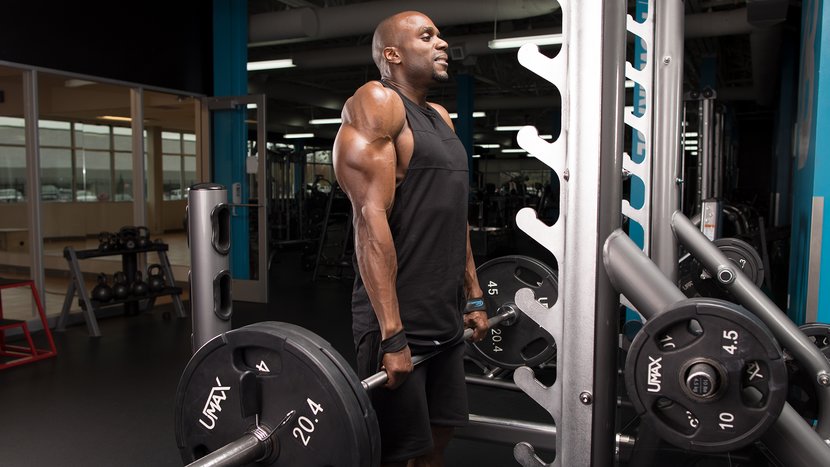8 Insider Tips To Build Your Ultimate Traps!
When you see someone with a big set of boulder shoulders, you can't help but think of raw, rugged power—and traps are a big part of that. You'd be hard pressed to find a pro bodybuilder, pro wrestler, strongman competitor, or NFL lineman who doesn't own thick, bulging traps that surround their neck like a couple of footballs.
But, let's face it, training traps doesn't exactly provide instant gratification. If you're like most lifters, you've done plenty of sets of shrugs without getting those beefy traps you're after.
At this point in your training, you might have given up on your traps and figured they're about as good as they're going to get. But what if I told you there are ways to make your trapezius training infinitely more exciting and productive? What if I told you your traps can be bigger and better than they are now—no matter how long you've been training them?
Most people don't have the kind of traps they want because they aren't training them the right way. I got together with fitness model and IFBB men's physique pro Craig Capurso to come up with eight tips guaranteed to get your traps busting out with new growth.
Tip 1: Work Them First!
If you're like most lifters, you train your traps at the end of a back workout that might include chin-ups, lat pull-downs, barbell rows, dumbbell rows, machine rows, T-bar rows, cable rows, pull-overs, and deadlifts.
"By the time you begin working traps," Capurso says, "you've already pulled thousands of pounds of weight over anywhere from 15-25 work sets. Don't tell me you still have the energy and focus at that point to give your traps the attention they need to grow! If this is the way you've been training, your poor traps never even had a fighting chance."

If that sounds like you, it's time to buck that meathead convention and work your traps before your lats. "Blasphemy," you say, "Nobody does it that way!" But if you haven't seen the kind of trap growth you want, you've got to make this wild and crazy change. Work your traps when you're fresh and you'll be amazed at how much heavier you can go, and what a better pump you can achieve.
Tip 2: Full ROM For Shrugs
Everybody who's trying to build traps does shrugs with either dumbbells, a barbell, or a machine. One thing most of them do wrong is to go way too heavy, which further reduces this exercise's already very short range of motion (ROM). This happens a lot when people use a barbell or a machine because of the temptation to load up as many 45s as possible.
"Sometimes you see guys with five or six hundred pounds stacked onto a bar," says Capurso. "What they end up doing looks more like a muscle spasm than a legitimate shrug."
Reducing the ROM also reduces stimulation to your traps, and it is this stimulation that leads to growth. To keep the ROM as wide as you can, start by letting your traps fully stretch at the bottom, then shrug upward to a full contraction. Capurso likes to visualize the contraction as trying to touch your traps to your ears.
Just as half reps on squats or leg presses won't allow you to build your thighs to their full potential, nothing less than full-range shrugs will do the job for your traps. Yes, you sacrifice weight, but this isn't a competition to see how much weight you can shrug. The goal is to build up your traps.
Tip 3: Higher Reps For The Win
Since shrugs have such a short ROM, you've got to do more reps than normal to get proper stimulation. The standard 8-12 reps usually aren't enough keep the traps under tension long enough, so move into the 12-15, or even 15-20, rep range.
"I like using the heavy volume principles when I train my traps," Capurso says. "I pick a weight at which 15 reps would be a challenge and go until I can't lift the bar another rep. Your form may get a little loose at the end, but if you're using a smart cheat technique here, you can overload the muscle and take your training to the next level. Take 2 minutes to catch your breath, and hit it again for three sets."
Once you up your reps, you'll start feeling the soreness in your traps that means growth is on the way.

Tip 4: The Forgotten Trap Builder
Shrugs are a great trap exercise, but they're not the only one. The upright row is a compound movement that brings the rear delts and biceps into play to drive your traps into a deeper state of exhaustion.
When you do upright rows with your grip at shoulder width or more, you focus the energy on your delts. But, if you place your hands in a narrow grip (6-8 inches apart), the row turns into a trap annihilator! Start from a hang, and pull until the bar is at mid-chest level, keeping your elbows angled up to the sky. The pump and burn you feel in your traps will make you wonder why you haven't been doing these since day one of training.
"Take the upright row a step further by doing a power pull as you approach the end of your range of motion," says Capurso. "That sheer power you apply to get the extra pull uses a bit more momentum, which targets the fast twitch muscle fibers in your traps and leads to more growth."

Cellucor COR-Performance Whey
Great Tasting Protein with Minimal Fat and Carbs and Added Digestive Enzymes
Tip 5: Supersets And Dropsets Mean Super Traps
Just as most people never do anything else but shrugs for traps, they also tend to stick with standard straight sets. If this approach has been delivering the gains for you, wonderful! If not, it's time to shock your traps with something they aren't expecting.
Supersets are a great way to provide new stimulation to your trapezius muscles. The best combination I've found is to follow shrugs immediately with narrow-grip barbell upright rows. This is a classic pre-exhaust superset: Shrugs isolate and fatigue the traps, and upright rows bring in the shoulders and arms to really torch your traps.
Three or four rounds of 10-15 reps each of this superset and your traps should have all the stimulation they need for a sweet little growth spurt.
Dropsets are another good technique. However, unless you have a training partner to help you strip plates, dumbbell shrugs are a better option than a barbell or plate-loading machine. Warm up to using your heaviest weight, then immediately rack those and pick up a lighter pair. If you're really in a masochistic mood, do yet another, lighter set right after that. Your traps will be screaming—and on their way to growing.
Tip 6: Strap It On And Go Heavier
Some people insist that wrist straps are for sissies, and that you'll develop a much stronger grip without them.
"I've never been in a conversation that started with, 'Wow, your hands are so strong!' If you want to make your muscle bigger and stronger, then wrap and pull," says Capurso.

Your grip will always be a weak link when it comes to training the large, powerful muscles of the back, including the traps. If your grip gives out before your traps have truly fatigued, you'll never develop them to their fullest capacity. Most men who are strong can do good reps on barbell shrugs with 405 pounds or more. Not many would be able to hold that much weight for a 12-rep set without straps.
There's no reason to think that using wrist straps is somehow "cheating" or "not hardcore." Your only concern, assuming you are training to develop the best physique you can, is to work the muscles as hard and as effectively as possible. So strap up for big weight!
Tip 7: Hit Traps Twice A Week
Any stubborn body part can benefit from some extra attention. If your traps aren't living up to your hopes and dreams, start hitting them twice a week. Work them once at the start of one workout (say, for back), then again at the tail end of another session (maybe on chest or shoulder day).
Hit your traps like this and they'll have no choice but to adapt. If they're always sore, or if they stop responding to this format, dial it back to once a week. But, by the time that happens, you should already have witnessed some major trap improvements.
Tip 8: Stretch Those Traps Hard!
Finally, there is a great deal of anecdotal evidence that doing stretches to loosen muscle fascia can free up muscles and allow them to expand and grow. A good end-of-training stretch for the fascia surrounding the trapezius is to strap on a heavy barbell, or pair of dumbbells, and let your arms hang down in the fully stretched position for 30-60 seconds. It's one of those pains that feels so good!






Comments
Post a Comment